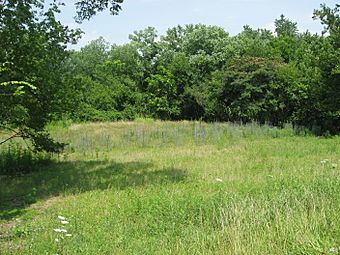Clough Creek and Sand Ridge Archaeological District facts for kids
Quick facts for kids |
|
|
Clough Creek and Sand Ridge Archeological District
|
|

Fields at the Sand Ridge Site
|
|
| Location | Along the ridge to the west of the Union Bridge |
|---|---|
| Nearest city | Cincinnati, Ohio |
| Area | 70 acres (28 ha) |
| NRHP reference No. | 74001509 |
| Added to NRHP | October 1, 1974 |
The Clough Creek and Sand Ridge Archaeological District is a special area in Ohio. It's like a historical park, but instead of buildings, it protects two important places where ancient people lived. These places are called archaeological sites. They are found in the southwestern part of the state.
This district gets its name from two main spots. One site is along a stream called Clough Creek. This creek flows into the Little Miami River. The other site is on a raised area known as Sand Ridge, which is close to the creek.
Contents
Discovering Ancient Homes
This district helps us learn about people who lived here long, long ago. Archaeologists study these sites to understand how ancient communities lived. They look for clues left behind in the ground.
The Clough Creek Site
The Clough Creek Site is about 2 acres (0.81 ha) big. That's like two football fields! Even though archaeologists haven't dug deep here yet, they believe it was once a large village. Imagine a whole community living there centuries ago!
The Sand Ridge Site
The Sand Ridge Site is not far from Clough Creek, about 0.3 miles (0.48 km) away. It sits on a noticeable ridge west of the old Union Bridge. People have known about this important site for a long time.
Back in the 1880s, many people would visit Sand Ridge. They would often find interesting things on the surface. These included old bones, pieces of pottery, and sharp flint tools.
It seems the people who lived at Sand Ridge didn't stay all year. They likely lived there only during certain seasons, probably in autumn and winter. Fish was a very important food for them. Archaeologists have found many fish bones, including those from suckers, channel catfish, and freshwater drums.
What Archaeologists Found
In 1884, archaeologists from the Peabody Museum of Archaeology and Ethnology explored a special area at Sand Ridge. This area was a "midden," which is like an ancient trash dump. It's full of clues about daily life!
They found many amazing things for the museum's collection. These included different kinds of stone tools, bones from birds and deer, and projectile points. Projectile points are the sharp tips of spears or arrows.
More recently, people have also found artifacts on the surface at Clough Creek. These include scrapers, which were used to clean animal hides, and more projectile points. Experts believe some artifacts at Clough Creek might be buried as deep as 5 feet (1.5 m) underground.
Connecting the Sites
Even though Clough Creek and Sand Ridge are separate, archaeologists think they are closely related. The artifacts found at Sand Ridge tell us that the people belonged to the Fort Ancient culture. This culture was active in this region a long time ago.
This idea comes mostly from the pottery found at Sand Ridge. It looks very similar to pottery from other important Fort Ancient sites, like the Madisonville and State Line Sites.
An interesting discovery at Sand Ridge is that it was used by two different groups of people. The Fort Ancient village was built on top of an even older settlement. This earlier group belonged to the Late Woodland period.
Why These Sites Are Important
In 1974, the Clough Creek and Sand Ridge Archaeological District was added to the National Register of Historic Places. This means it's a very important historical place. It has the potential to teach us a lot about the past.
There are other similar ancient villages nearby in Newtown. These include the Perin, Turpin, and Hahn Field Sites. Like Clough Creek and Sand Ridge, Turpin and Hahn Field were also Fort Ancient villages built on top of older Woodland period settlements. The Perin Village and Odd Fellows' Cemetery Mound are sites from only the Woodland period.



